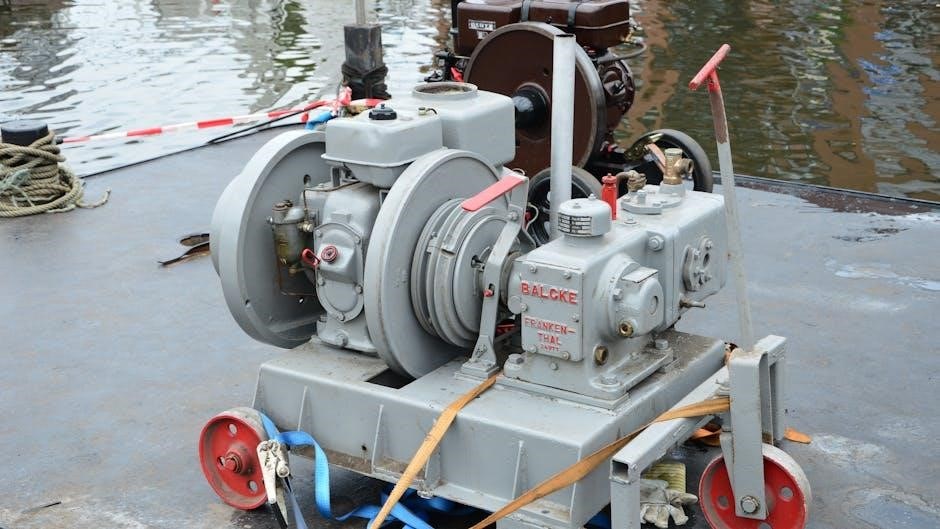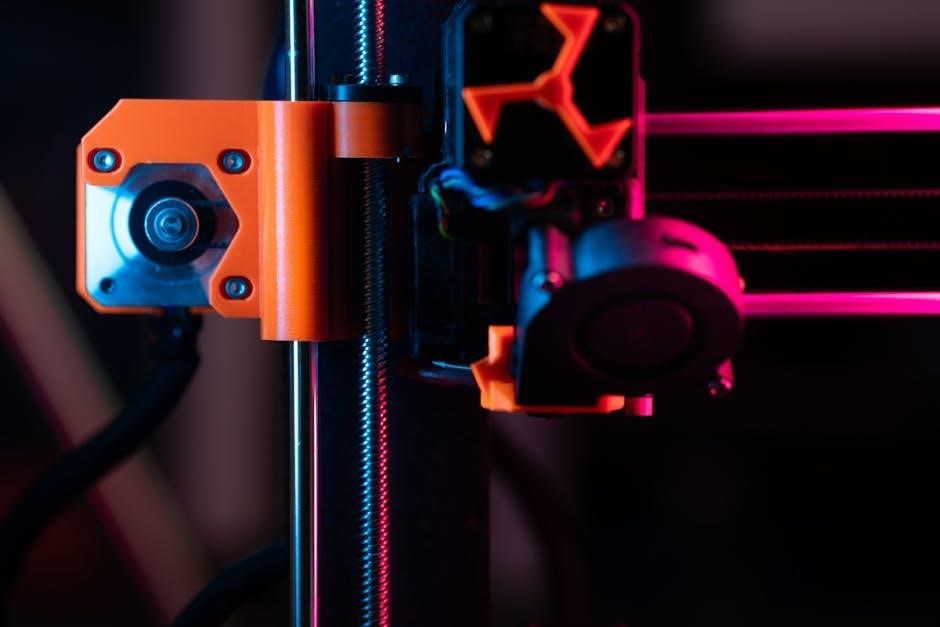An engine is a machine that converts energy into mechanical force, enabling motion and power for vehicles and machinery. Understanding its operation and maintenance is essential for optimal performance and longevity.
1.1 What is an Engine?
An engine is a machine designed to convert energy into mechanical force or motion. It serves as the heart of vehicles and machinery, enabling them to operate efficiently. Engines work by transforming various forms of energy, such as chemical energy from fuel or electrical energy, into rotational or linear motion. Internal and external combustion engines are the primary types, with internal combustion engines burning fuel inside the engine and external combustion engines burning fuel outside. Understanding the basic function and components of an engine is crucial for proper maintenance and performance optimization.
- Engines convert energy into motion for powering vehicles and machinery.
- Internal combustion engines burn fuel internally, while external combustion engines burn fuel externally.
- The engine’s efficiency and longevity depend on regular maintenance and understanding its components.
1.2 Importance of Engine Maintenance
Regular engine maintenance is crucial for ensuring optimal performance, preventing costly repairs, and extending the lifespan of your vehicle. Proper care helps maintain fuel efficiency, reduces emissions, and ensures reliability. A well-maintained engine reduces the risk of breakdowns and enhances overall vehicle safety. Essential tasks include oil changes, coolant inspections, and air filter replacements. Following a maintenance schedule tailored to your engine type and usage ensures all components function smoothly. Neglecting maintenance can lead to premature wear, reduced power, and potential engine failure. Consistent upkeep not only saves money but also ensures your engine operates efficiently for years to come.
- Prevents costly repairs and extends engine lifespan.
- Improves fuel efficiency and reduces emissions.
- Ensures vehicle reliability and safety.
- Requires regular tasks like oil changes and coolant checks.
- Customize maintenance based on engine type and usage.

Types of Engines
Engines are categorized into internal combustion engines, external combustion engines, and electric engines. Internal combustion engines burn fuel inside, while external combustion engines burn fuel outside, offering different efficiencies and applications.
2.1 Internal Combustion Engines
Internal combustion engines (ICEs) operate by burning fuel within a combustion chamber inside the engine. This process generates mechanical energy, which powers vehicles or machinery. ICEs are widely used in cars, motorcycles, and small machinery due to their compact size and high power output. They rely on air-fuel mixture compression, ignition, and combustion to produce energy. Regular maintenance, including oil changes and spark plug replacements, is crucial for longevity. ICEs are further divided into gasoline and diesel types, each with distinct characteristics and maintenance requirements. Despite advancements in electric engines, internal combustion engines remain dominant in many applications, offering proven reliability and performance.
2.2 External Combustion Engines
External combustion engines (EC engines) generate power by burning fuel outside the engine’s main structure. The combustion process heats a working fluid, such as water, which then drives the engine through mechanisms like steam expansion. Common examples include steam engines and certain industrial power plants. These engines are often used in stationary applications, such as electricity generation, due to their ability to handle large-scale energy production. EC engines are generally quieter, produce fewer emissions, and can utilize alternative fuels, making them environmentally friendly. However, they are bulkier and less efficient in energy conversion compared to internal combustion engines. Regular maintenance of heat exchangers and fluid systems is essential for optimal performance and longevity.
2.3 Gasoline vs. Diesel Engines
Gasoline and diesel engines differ fundamentally in their combustion processes. Gasoline engines rely on spark plugs to ignite the fuel-air mixture, while diesel engines use compression to ignite the fuel, resulting in higher torque at lower speeds. Diesel engines generally offer better fuel efficiency, especially for heavy-duty applications, but produce more particulate emissions. Gasoline engines, on the other hand, are lighter, quieter, and better suited for high RPM performance. Maintenance requirements vary: diesel engines need careful fuel quality control and filter maintenance, while gasoline engines require regular spark plug replacements. Emissions standards have narrowed the gap between the two, but diesel engines still excel in towing and long-distance efficiency, whereas gasoline engines are preferred for lighter, faster vehicles. Choosing the right type depends on specific needs, such as fuel efficiency, performance, and budget constraints.

Engine Maintenance Essentials
Regular engine maintenance is crucial for longevity and performance. Key tasks include oil changes, coolant checks, air filter replacements, and spark plug inspections to prevent breakdowns and ensure smooth operation.
3.1 Oil Changes and Lubrication
Oil changes are a cornerstone of engine maintenance, ensuring proper lubrication of moving parts to reduce friction and prevent overheating. Regular oil changes, typically every 3,000 to 5,000 miles, remove contaminants and wear metals that can damage the engine. Using the correct type of oil, such as conventional, synthetic, or synthetic blend, is vital for optimal performance. Neglecting oil changes can lead to premature wear, increased fuel consumption, and even engine failure. Always refer to your vehicle’s manual for the recommended oil type and change interval. Proper lubrication is essential for extending the life of your engine and maintaining its efficiency and power.
3.2 Cooling System Maintenance
Maintaining the cooling system is crucial for preventing engine overheating, which can cause severe damage. Key components include the radiator, coolant, hoses, and water pump. Regularly inspect hoses for cracks or leaks and ensure the coolant level is adequate. Flush and replace coolant every 30,000 to 50,000 miles to prevent corrosion and maintain its effectiveness. Additionally, check the radiator for blockages and ensure the thermostat functions properly. Overheating can lead to costly repairs, including head gasket failure or cylinder damage. A well-maintained cooling system ensures your engine operates within a safe temperature range, enhancing performance and longevity. Always use the recommended coolant type for your vehicle to avoid compatibility issues and maintain optimal efficiency.
3.3 Air Filter Replacement
Air filter replacement is essential for maintaining engine efficiency and performance. A dirty air filter restricts airflow, reducing fuel efficiency, power, and overall engine health. It can also increase emissions and strain the engine. Regularly inspect and replace the air filter every 15,000 to 30,000 miles, depending on driving conditions. Dusty or polluted environments may require more frequent changes. A clean air filter ensures proper air-fuel mixture, optimizing combustion and performance. Always use the correct type of air filter recommended by your vehicle’s manufacturer to maintain engine longevity. Neglecting this maintenance can lead to decreased mileage, sluggish acceleration, and potential damage to engine components over time.
3.4 Spark Plug Inspection
Spark plug inspection is crucial for maintaining engine performance and efficiency. Worn-out spark plugs can lead to decreased power, reduced fuel efficiency, and increased emissions. Typically, spark plugs should be inspected every 30,000 to 100,000 miles, depending on the vehicle and type of plugs. Look for signs of wear, such as fouling, wear on the electrode, or a cracked porcelain insulator. Neglecting spark plug maintenance can result in engine misfires, rough idling, and potentially costly damage to the catalytic converter or ignition coil. Always use the correct spark plug type recommended by your vehicle’s manufacturer for optimal performance. Regular inspection and replacement ensure smooth engine operation and prevent unnecessary repairs.

Engine Components
Engine components include cylinders, pistons, crankshafts, and camshafts, working together to convert fuel into mechanical energy. Proper maintenance ensures optimal performance and longevity.
4.1 Key Parts of an Engine
An engine consists of several critical components that work together to convert energy into motion. The cylinder block houses the cylinders, where the combustion process occurs. Inside these cylinders, pistons move up and down, driven by explosive forces. The crankshaft converts this reciprocating motion into rotational energy, which powers the vehicle. The camshaft operates the valvetrain, controlling the flow of air and fuel into the cylinders and exhaust gases out. Other essential parts include the oil pump, which lubricates moving components, and the cooling system, which regulates engine temperature. Modern engines also rely on the engine control unit (ECU) to manage operations. These components must function seamlessly for efficient performance and longevity.
4.2 Function of Pistons and Cylinders
The pistons and cylinders are fundamental components in an engine’s operation. Cylinders act as chambers where the combustion process takes place, generating power. Inside each cylinder, a piston moves vertically, driven by the explosive force of fuel ignition. This movement is transferred to the crankshaft, converting it into rotational energy. The pistons are sealed tightly within the cylinders by rings, ensuring minimal gas leakage and efficient energy transfer. Proper alignment and lubrication of these parts are crucial to prevent overheating and wear. Together, the pistons and cylinders form the heart of the engine, enabling the conversion of combustion energy into mechanical motion that powers the vehicle.
4.3 Role of the Crankshaft and Camshaft
The crankshaft and camshaft are critical components in an engine’s operation. The crankshaft converts the up-and-down motion of the pistons into rotational energy, which is then transferred to the vehicle’s wheels. It is connected to the pistons via connecting rods and plays a key role in balancing the engine to minimize vibrations. The camshaft, on the other hand, controls the opening and closing of the engine’s valves, ensuring air and fuel enter the cylinders and exhaust gases are expelled efficiently. It is typically driven by the crankshaft via a timing belt or chain, synchronizing the engine’s intake and exhaust processes for optimal performance.

Engine Performance Optimization
Engine performance optimization involves enhancing efficiency and power through tuning, upgrading air filters, optimizing ignition timing, and using high-quality fuel. Regular servicing and reducing vehicle weight further improve performance.
5.1 Fuel Efficiency Tips
Improving fuel efficiency is crucial for reducing costs and environmental impact. Regular oil changes ensure optimal engine lubrication, while clean air filters enhance airflow. Driving habits, such as maintaining consistent speeds and avoiding aggressive acceleration, significantly impact fuel consumption. Properly inflated tires and reducing vehicle weight also contribute to better mileage; Additionally, using fuel-efficient engine oils and avoiding idling can make a noticeable difference. Regular tune-ups, including spark plug inspections, ensure the engine operates at its best. By combining these practices, drivers can maximize fuel efficiency, extend engine life, and lower overall vehicle maintenance costs. Consistent monitoring and adjustments based on driving conditions further enhance these benefits, making fuel efficiency a key aspect of engine performance optimization.
5.2 Performance Modifications
Performance modifications can significantly enhance your engine’s power and efficiency. Upgrading to a high-performance air filter or exhaust system improves airflow and reduces backpressure, allowing the engine to breathe better. Engine tuning, such as recalibrating the ECU or installing a performance chip, optimizes fuel injection and ignition timing for increased horsepower and torque. Lightweight components, like aluminum pistons or titanium valves, reduce weight and improve responsiveness. Additionally, aftermarket turbos or superchargers force more air into the engine, boosting power output. When considering modifications, consult a qualified mechanic to ensure compatibility and avoid damaging your engine. Always prioritize quality parts and adhere to local emissions regulations for safe and reliable performance enhancements.

Common Engine Repairs
Common engine repairs include oil changes, tune-ups, and spark plug replacements. Addressing issues like worn piston rings or faulty valves early prevents costly overhauls and ensures reliability.
6.1 Tune-Ups and Minor Repairs
Tune-ups and minor repairs are crucial for maintaining engine health; These include replacing spark plugs, air filters, and checking fluid levels. Regular inspections help identify issues early, reducing the risk of major breakdowns. Spark plugs, for instance, should be replaced every 30,000 to 100,000 miles to ensure proper ignition. Air filters, if clogged, can lower fuel efficiency and performance, so they need regular cleaning or replacement. Additionally, coolant and oil checks are vital to prevent overheating and wear. Addressing these minor issues promptly ensures smoother engine operation and extends its lifespan. Remember, a well-maintained engine performs better and requires fewer costly repairs over time.
6.2 Engine Rebuilds and Overhauls
Engine rebuilds and overhauls are major repairs performed when an engine has significant wear or damage. This process involves disassembling the engine, inspecting each component, and replacing or repairing worn parts. Typically done every 150,000 to 200,000 miles, a rebuild restores the engine to near-original condition. Key steps include replacing pistons, rings, bearings, and valves, as well as resurfacing or replacing the cylinder head and block. Proper tools and expertise are essential, as improper assembly can lead to further damage. While rebuilding is costly, it extends the engine’s life and improves performance. If unsure, consulting a professional mechanic is highly recommended to ensure the job is done correctly.
